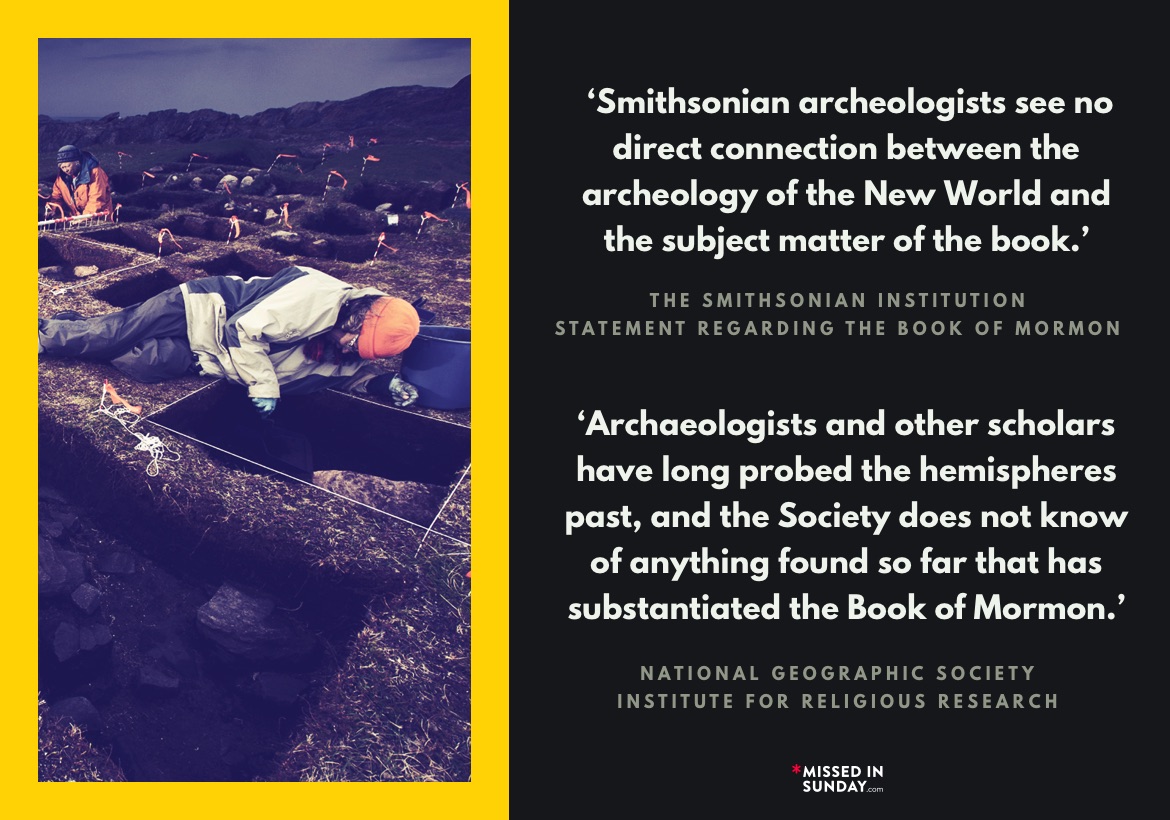Indian turning white. A Winnebago Indian, Louis Armell, living on the reservation, is said to be the object of scientific observation because for many years his skin has gradually been turning white. He is now 54 years old. He still has “copper patches” but physicians believe that if he lives a few more years he will become entirely white.
Improvement Era, April 1928 Issue 6, Page 537 (Page 91 of the linked PDF)
https://catalog.churchofjesuschrist.org/assets/4b787529-9a83-49d1-85df-d973548a6e2c/0/0
Tag: Indian
-
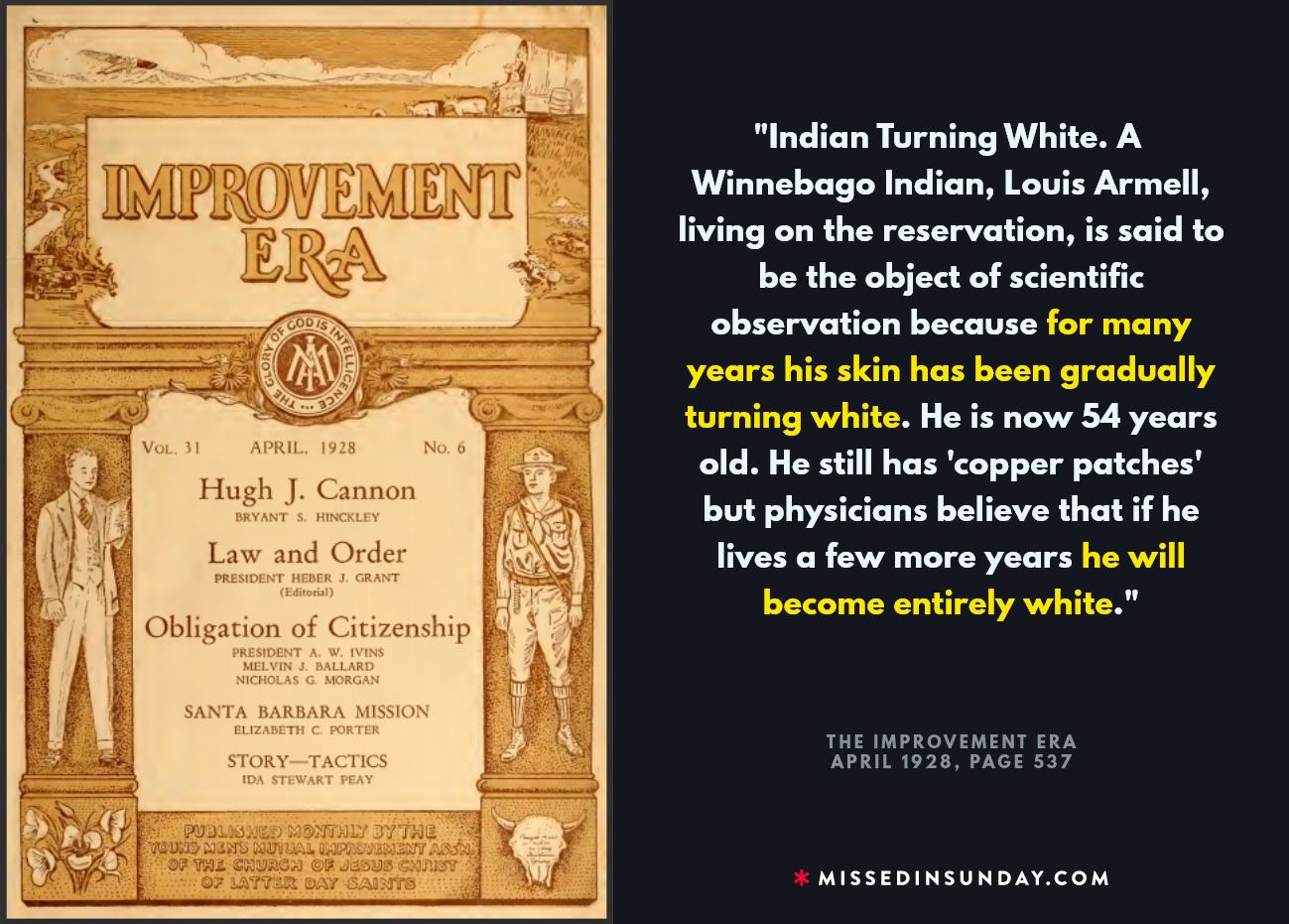
Indian Turning White, Improvement Era
-
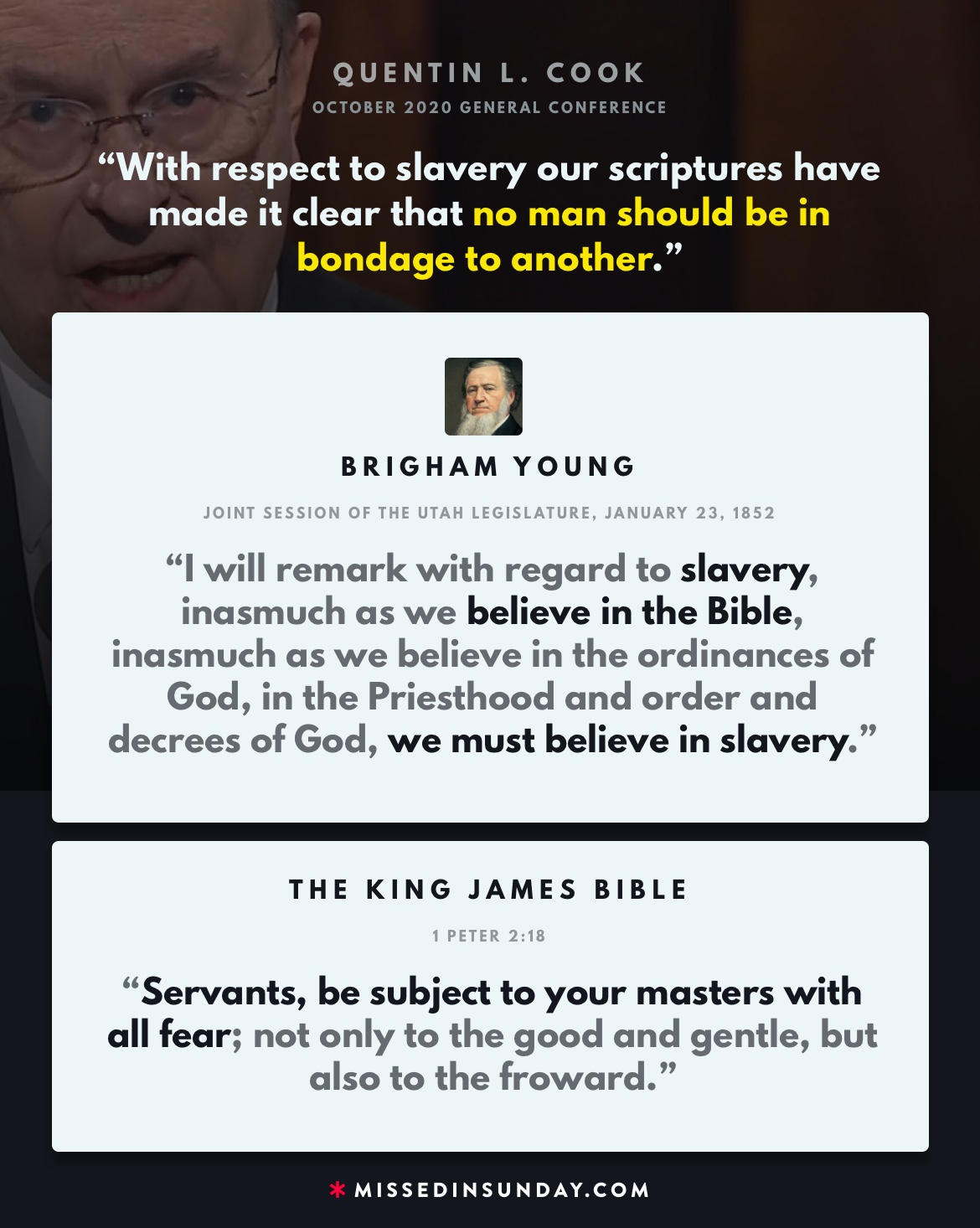
Slavery in Scriptures
Excerpt from an October 2020 General conference talk by Quentin L. Cook:1
This was a time of tension on several fronts. Many Missourians considered Native Americans a relentless enemy and wanted them removed from the land. In addition many of the Missouri settlers were slave owners. And felt threatened by those who were opposed to slavery.
In contrast our doctrine respected the Native Americans and our desire was to teach them the gospel of Jesus Christ.
With respect to slavery our scriptures have made it clear that no man should be in bondage to another.
From the Bible, 1 Peter 2:18:2
18 Servants, be subject to your masters with all fear; not only to the good and gentle, but also to the froward.
On February 4, 1852 an ‘Act of Relation to Service’ was passed in the Utah territory, making slavery legal. 1 Several weeks later, the ‘Act for the Relief of Indian Slaves and Prisoners’ was passed on March 7, 1852, specifically dealing with Indian slavery. 3
…
A speech by Governor Brigham Young in Joint Session of the Legislature, January 23, 1852: 3
“I have this section in my hand, headed “An Act in Relation to African Slavery.” I have read it over and made a few alterations. I will remark with regard to slavery, inasmuch as we believe in the Bible, inasmuch as we believe in the ordinances of God, in the Priesthood and order and decrees of God, we must believe in slavery. This colored race have been subjected to severe curses, which they have in their families and their classes and in their various capacities brought upon themselves. And until the curse is removed by Him who placed it upon them, they must suffer under its consequences; I am not authorized to remove it. I am a firm believer in slavery.
Now to the case before us with regard to slavery, with regard [to] slaves that [are] Africans, or that are English, or that [are] Dutch, or ourselves—I go in for making just such laws as we want upon that matter, independent of any other nation under the heavens; let us do that [which will bring about what] we want to be done regardless of the abuses of despotic governments. Whether they deem it to be right or wrong is no matter to me, but to do the thing we ought to do, to secure those blessings we are in pursuit of, ought to be the first and most weighty consideration with us; that is my mind upon this matter. This case comes up and causes feelings of not a pleasing character in the minds of some.
The African enjoys the right of receiving the first principles of the Gospel; this liberty is held out to all these servants. They enjoy the liberty of being baptized for the remission of sins and of receiving the Holy Ghost by the laying on of hands; they enjoy the privilege of living humbly before the Lord their great Master, so as to enjoy the spirit of the Lord continually. In short, as far as the common comforts of life, salvation, light, truth, enjoyment, and understanding are concerned, the Black African has precisely the same privilege as the white man. But they cannot share in the Priesthood; they cannot bear rule; they cannot bear rule in any place until the curse is removed from them; they are a “servant of servants.” We are servants, as Counselor George Smith has stated; he says he is a slave; he has been driven from his home and his rights—we are all servants. Now suppose that we should have a servant, and he should be a Negro; it is all right; it is perfectly reasonable and strictly according to the Holy Priesthood. I loathe the abuses to which the slave in a great many instances is exposed, although as a general thing that part of the Negro race that are in servile bondage, are much more comfortable and better provided for than the lower classes of the nations of Europe.
Though the enlightened nation, England, has abolished slavery in her colonies, yet the most damnable slavery exists at the very heart of the nation. I am bold to say that you cannot find a Black man or woman in the United States that has traveled through the period of his life in hunger in the midst of plenty. Yet there are millions upon millions in the cities of Europe who have lived amidst the choicest luxuries of life and died at last in starvation; thousands died of starvation in England the year that I was in that country. That is meaner slavery than to set them to work in growing cotton and sugar, etc. I would not wish to go to the enlightened nation of England to know what slavery is because they are so far sunken in iniquity and so deeply degraded. People contend about it to know what it is; we know it exists, and such a thing shall and will exist until the Lord God shall remove it; until then it will and ought to exist. There are many brethren in the South, a great amount of whose means is vested in slaves. Those servants want to come here with their masters; when they come here, the Devil is raised. This one is talking, and that one is wondering. A strong abolitionist feeling has power over them, and they commence to whisper round their views upon the subject, saying, “Do you think it’s [146] right? I am afraid it is not right.” I know it is right, and there should be a law made to have the slaves serve their masters, because they are not capable of ruling themselves.
When the Lord God cursed old Cain, He said, “Until the last drop of Abel’s blood receives the Priesthood, and enjoys the blessings of the same, Cain shall bear the curse;” then Cain is calculated to have his share next and not until then; consequently, I am firm in the belief that they ought to dwell in servitude.
The caption of this bill I don’t like, I have therefore taken the liberty to alter it. I have said, “An Act in Relation to Manual Service,” instead of “African Slavery.” I have also altered the latter part of it. I am willing the bill should be thrown back to be remodeled.
I would like masters to behave well to their servants, and to see that every person in this territory is well used. When a master has a Negro and uses him well, he is much better off than if he was free. As for masters knocking them down and whipping them and breaking the limbs of their servants, I have as little opinion of that as any person can have; but good wholesome servitude, I know there is nothing better than that.
Suppose I am in England and bring over 100 persons, males and females, and they pledge themselves to pay me in labor, but as soon as they arrive here they refuse to abide by their contract and turn around and abuse their benefactors. See the abuse that Dan Jones has received, who prevailed upon Sister Lewis to spend almost every dime she possessed to help individuals to this place; they curse both her and him and this they will continue to do, waxing worse and worse until they go down to hell (I say they ought to be her servants). Many more such cases could be brought to bear. There should be a law to govern this, that those who have made contracts to labor, they may perform their labors according to said contracts.”
References
References 1 2020 General conference talk by Quentin L. Cook – https://www.churchofjesuschrist.org/broadcasts?lang=eng&video=October-2020-General-Conference 2 Peter 2:18, King James Version Bible – https://www.churchofjesuschrist.org/study/scriptures/nt/1-pet/2?lang=eng 3 Speech by Governor Brigham Young in Joint Session of the Legislature, January 23, 1852 – https://archive.org/details/CR100317B0001F0014 -
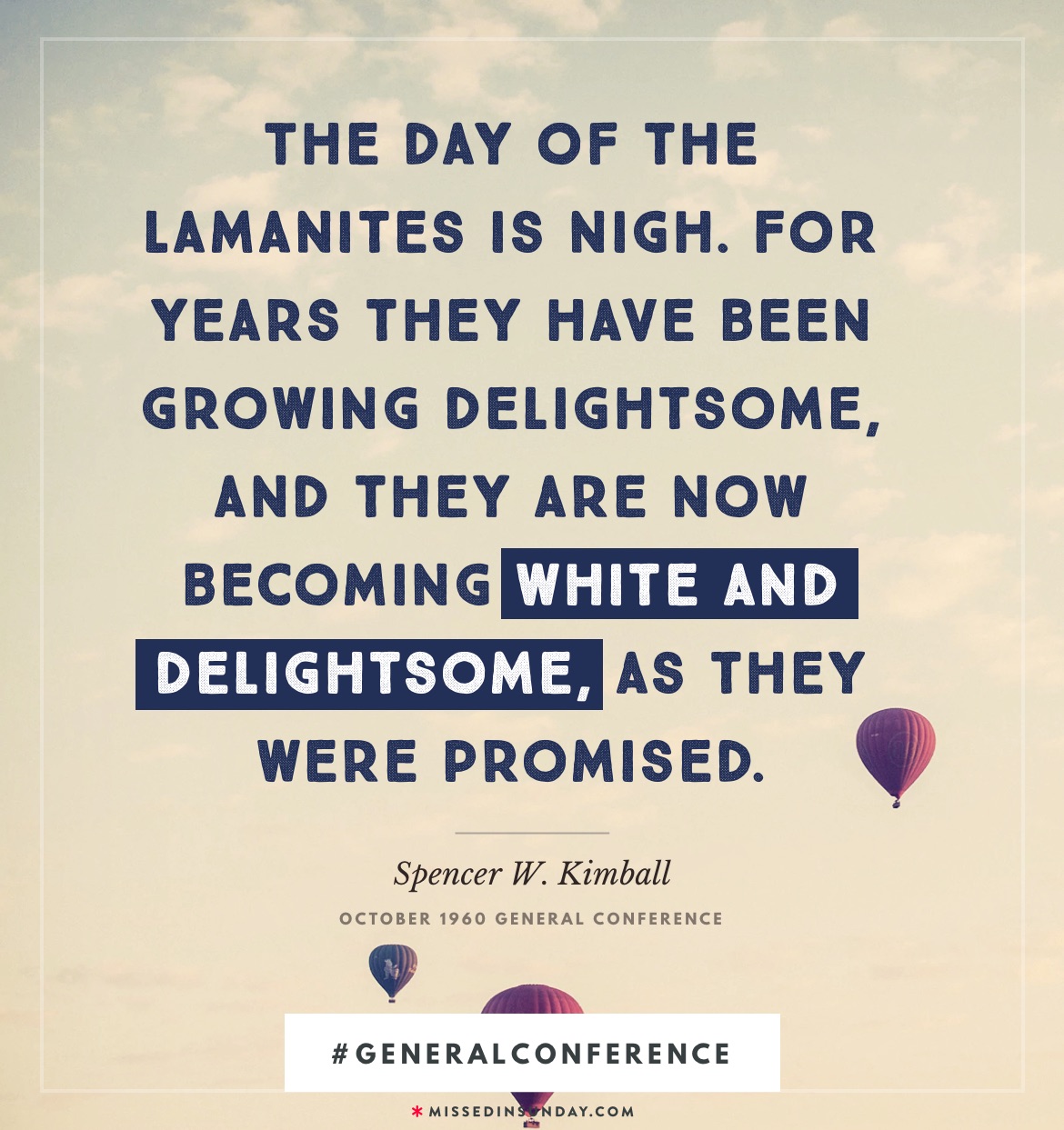
Day of the Lamanites
Excerpt from an October 1960 General Conference Address by Spencer W. Kimball: 1
“The work is unfolding, and blinded eyes begin to see, and scattered people begin to gather. I saw a striking contrast in the progress of the Indian people today as against that of only fifteen years ago. Truly the scales of darkness are falling from their eyes, and they are fast becoming a white and delightsome people.”
“The day of the Lamanites is nigh. For years they have been growing delightsome, and they are now becoming white and delightsome, as they were promised. In this picture of the twenty Lamanite missionaries, fifteen of the twenty were as light as Anglos; five were darker but equally delightsome. The children in the home placement program in Utah are often lighter than their brothers and sisters in the hogans on the reservation.
At one meeting a father and mother and their sixteen-year-old daughter were present, the little member girl — sixteen — sitting between the dark father and mother, and it was evident she was several shades lighter than her parents — on the same reservation, in the same hogan, subject to the same sun and wind and weather. There was the doctor in a Utah city who for two years had had an Indian boy in his home who stated that he was some shades lighter than the younger brother just coming into the program from the reservation. These young members of the Church are changing to whiteness and to delightsomeness. One white elder jokingly said that he and his companion were donating blood regularly to the hospital in the hope that the process might be accelerated. “
References
References 1 Spencer W. Kimball, October 1960 General Conference – https://archive.org/details/conferencereport1960sa/page/n33 -
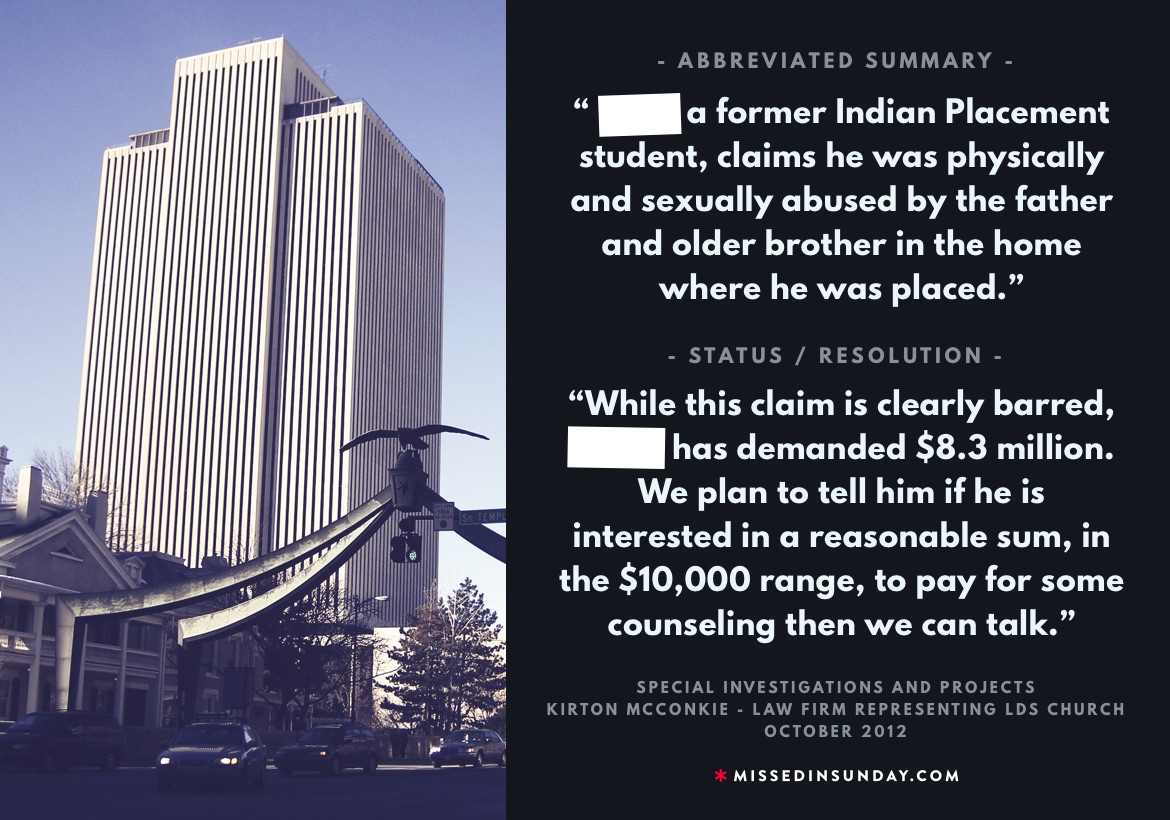
Indian Placement
Excerpt from a leaked document titled ‘Special Investigations and Projects’ by LDS Law Firm Kirton McConkie, October 2012: 1
References
References 1 Special Investigations and Products-Kirton McConkie, Mormon Leaks – https://mormonleaks.io/wiki/index.php?title=File:2012-10-31-Special_Investigations_and_Products-Kirton_McConkie.pdf -
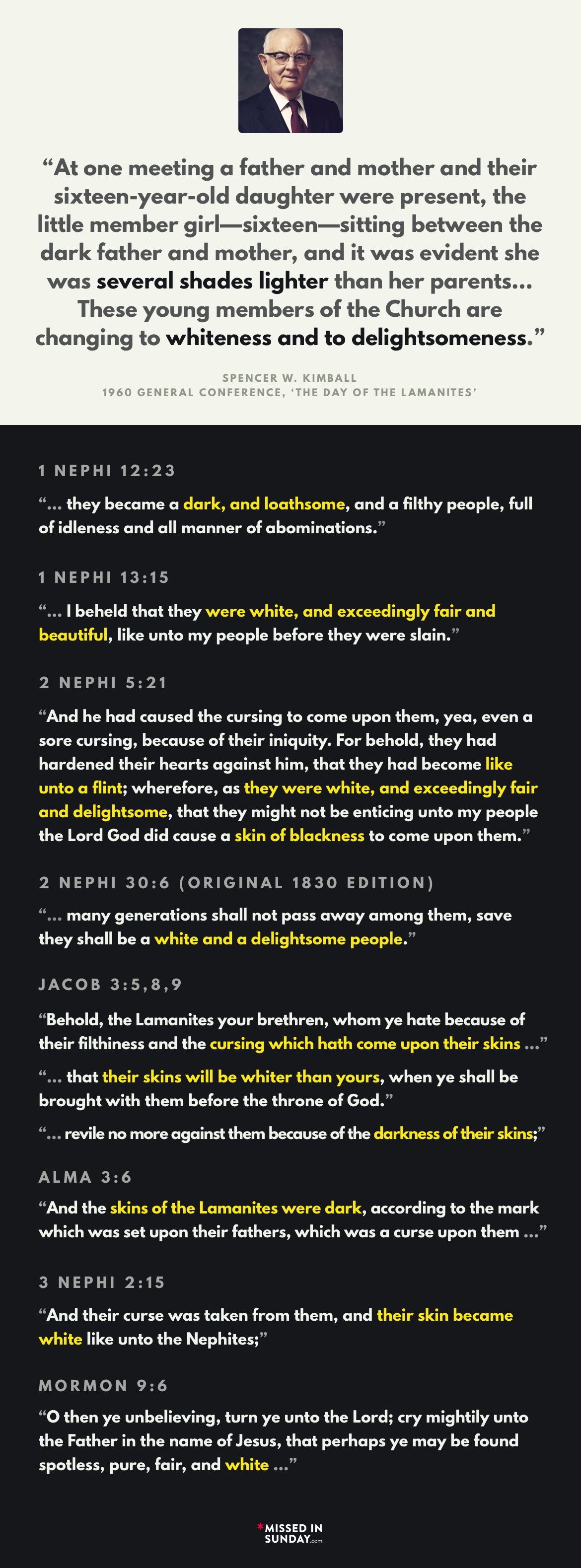
Skin
1 Nephi 12:23, Book of Mormon: 1
23 And it came to pass that I beheld, after they had dwindled in unbelief they became a dark, and loathsome, and a filthy people, full of idleness and all manner of abominations.
1 Nephi 13:15, Book of Mormon: 2
15 And I beheld the Spirit of the Lord, that it was upon the Gentiles, and they did prosper and obtain the land for their inheritance; and I beheld that they were white, and exceedingly fair and beautiful, like unto my people before they were slain.
2 Nephi 5:21-23, Book of Mormon: 3
21 And he had caused the cursing to come upon them, yea, even a sore cursing, because of their iniquity. For behold, they had hardened their hearts against him, that they had become like unto a flint; wherefore, as they were white, and exceedingly fair and delightsome, that they might not be enticing unto my people the Lord God did cause a skin of blackness to come upon them.
22 And thus saith the Lord God: I will cause that they shall be loathsome unto thy people, save they shall repent of their iniquities.
23 And cursed shall be the seed of him that mixeth with their seed; for they shall be cursed even with the same cursing. And the Lord spake it, and it was done.
2 Nephi 30:6, Book of Mormon (1830 Edition): 4
And then shall they rejoice: for they shall know that it is a blessing unto them from the hand of God; and their scales of darkness shall begin to fall from their eyes; and many generations shall not pass away among them, save they shall be a white and a delightsome people.
Jacob 3:5-9, Book of Mormon: 5
5 Behold, the Lamanites your brethren, whom ye hate because of their filthiness and the cursing which hath come upon their skins, are more righteous than you; for they have not forgotten the commandment of the Lord, which was given unto our father—that they should have save it were one wife, and concubines they should have none, and there should not be whoredoms committed among them.
6 And now, this commandment they observe to keep; wherefore, because of this observance, in keeping this commandment, the Lord God will not destroy them, but will be merciful unto them; and one day they shall become a blessed people.
7 Behold, their husbands love their wives, and their wives love their husbands; and their husbands and their wives love their children; and their unbelief and their hatred towards you is because of the iniquity of their fathers; wherefore, how much better are you than they, in the sight of your great Creator?
8 O my brethren, I fear that unless ye shall repent of your sins that their skins will be whiter than yours, when ye shall be brought with them before the throne of God.
9 Wherefore, a commandment I give unto you, which is the word of God, that ye revile no more against them because of the darkness of their skins; neither shall ye revile against them because of their filthiness; but ye shall remember your own filthiness, and remember that their filthiness came because of their fathers.
Alma 3:5-10, 14-17, Book of Mormon: 6
5 Now the heads of the Lamanites were shorn; and they were naked, save it were skin which was girded about their loins, and also their armor, which was girded about them, and their bows, and their arrows, and their stones, and their slings, and so forth.
6 And the skins of the Lamanites were dark, according to the mark which was set upon their fathers, which was a curse upon them because of their transgression and their rebellion against their brethren, who consisted of Nephi, Jacob, and Joseph, and Sam, who were just and holy men.
7 And their brethren sought to destroy them, therefore they were cursed; and the Lord God set a mark upon them, yea, upon Laman and Lemuel, and also the sons of Ishmael, and Ishmaelitish women.
8 And this was done that their seed might be distinguished from the seed of their brethren, that thereby the Lord God might preserve his people, that they might not mix and believe in incorrect traditions which would prove their destruction.
9 And it came to pass that whosoever did mingle his seed with that of the Lamanites did bring the same curse upon his seed.
10 Therefore, whosoever suffered himself to be led away by the Lamanites was called under that head, and there was a mark set upon him….
14 Thus the word of God is fulfilled, for these are the words which he said to Nephi: Behold, the Lamanites have I cursed, and I will set a mark on them that they and their seed may be separated from thee and thy seed, from this time henceforth and forever, except they repent of their wickedness and turn to me that I may have mercy upon them.
15 And again: I will set a mark upon him that mingleth his seed with thy brethren, that they may be cursed also.
16 And again: I will set a mark upon him that fighteth against thee and thy seed.
17 And again, I say he that departeth from thee shall no more be called thy seed; and I will bless thee, and whomsoever shall be called thy seed, henceforth and forever; and these were the promises of the Lord unto Nephi and to his seed.
3 Nephi 2:14-16, Book of Mormon: 7
14 And it came to pass that those Lamanites who had united with the Nephites were numbered among the Nephites;
15 And their curse was taken from them, and their skin became white like unto the Nephites;
16 And their young men and their daughters became exceedingly fair, and they were numbered among the Nephites, and were called Nephites.
Mormon 5:14-15, Book of Mormon: 8
14 And behold, they shall go unto the unbelieving of the Jews; and for this intent shall they go—that they may be persuaded that Jesus is the Christ, the Son of the living God; that the Father may bring about, through his most Beloved, his great and eternal purpose, in restoring the Jews, or all the house of Israel, to the land of their inheritance, which the Lord their God hath given them, unto the fulfilling of his covenant;
15 And also that the seed of this people may more fully believe his gospel, which shall go forth unto them from the Gentiles; for this people shall be scattered, and shall become a dark, a filthy, and a loathsome people, beyond the description of that which ever hath been amongst us, yea, even that which hath been among the Lamanites, and this because of their unbelief and idolatry.
Mormon 9:6, Book of Mormon: 9
6 O then ye unbelieving, turn ye unto the Lord; cry mightily unto the Father in the name of Jesus, that perhaps ye may be found spotless, pure, fair, and white, having been cleansed by the blood of the Lamb, at that great and last day.
:::
Excerpt from the October 1960 LDS General Conference, Spencer W. Kimball: 10
“At one meeting a father and mother and their sixteen-year-old daughter were present, the little member girl—sixteen—sitting between the dark father and mother, and it was evident she was several shades lighter than her parents—on the same reservation, in the same hogan, subject to the same sun and wind and weather. There was the doctor in a Utah city who for two years had had an Indian boy in his home who stated that he was some shades lighter than the younger brother just coming into the program from the reservation. These young members of the Church are changing to whiteness and to delightsomeness. One white elder jokingly said that he and his companion were donating blood regularly to the hospital in the hope that the process might be accelerated.”
References
References 1 1 Nephi 12:23, Book of Mormon – https://www.lds.org/scriptures/bofm/1-ne/12.23 2 1 Nephi 13:15, Book of Mormon – https://www.lds.org/scriptures/bofm/1-ne/13.15 3 2 Nephi 5:21-23, Book of Mormon – https://www.lds.org/scriptures/bofm/2-ne/5.21-23 4 2 Nephi 30:6, Book of Mormon (1830 Edition) – http://www.josephsmithpapers.org/paper-summary/book-of-mormon-1830/123 5 Jacob 3:5-9, Book of Mormon – https://www.lds.org/scriptures/bofm/jacob/3.5-9 6 Alma 3:5-10, 14-17, Book of Mormon – https://www.lds.org/scriptures/bofm/alma/3 7 3 Nephi 2:14-16, Book of Mormon – https://www.lds.org/scriptures/bofm/3-ne/2.14-16 8 Mormon 5:14-15, Book of Mormon – https://www.lds.org/scriptures/bofm/morm/5?lang=eng 9 Mormon 9:6, Book of Mormon – https://www.lds.org/scriptures/bofm/morm/9.6 10 The Day of the Lamanites -1960 General Conference, Spencer W. Kimball – http://scriptures.byu.edu/#:t443:g882 -
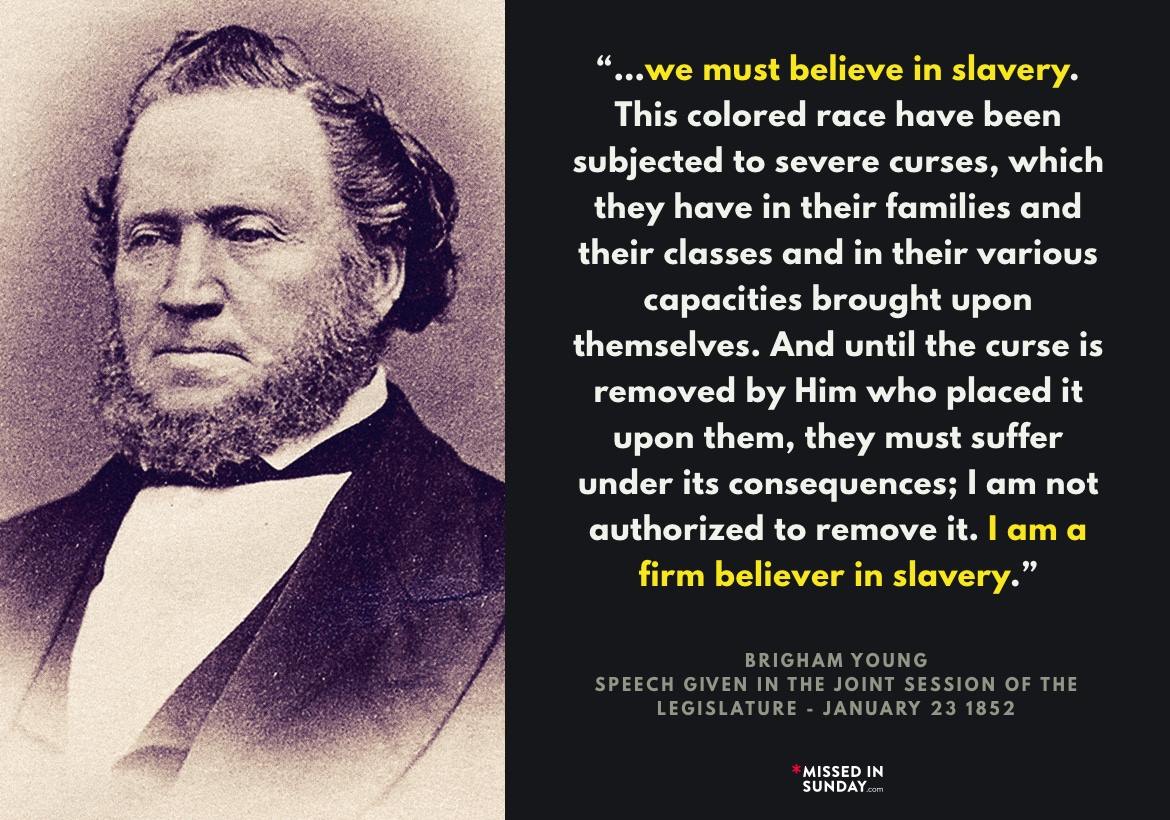
Believer in Slavery
On February 4, 1852 an ‘Act of Relation to Service’ was passed in the Utah territory, making slavery legal. 1 Several weeks later, the ‘Act for the Relief of Indian Slaves and Prisoners’ was passed on March 7, 1852, specifically dealing with Indian slavery. 2
…
A speech by Governor Brigham Young in Joint Session of the Legislature, January 23, 1852: 3
“I have this section in my hand, headed “An Act in Relation to African Slavery.” I have read it over and made a few alterations. I will remark with regard to slavery, inasmuch as we believe in the Bible, inasmuch as we believe in the ordinances of God, in the Priesthood and order and decrees of God, we must believe in slavery. This colored race have been subjected to severe curses, which they have in their families and their classes and in their various capacities brought upon themselves. And until the curse is removed by Him who placed it upon them, they must suffer under its consequences; I am not authorized to remove it. I am a firm believer in slavery.
Now to the case before us with regard to slavery, with regard [to] slaves that [are] Africans, or that are English, or that [are] Dutch, or ourselves—I go in for making just such laws as we want upon that matter, independent of any other nation under the heavens; let us do that [which will bring about what] we want to be done regardless of the abuses of despotic governments. Whether they deem it to be right or wrong is no matter to me, but to do the thing we ought to do, to secure those blessings we are in pursuit of, ought to be the first and most weighty consideration with us; that is my mind upon this matter. This case comes up and causes feelings of not a pleasing character in the minds of some.
The African enjoys the right of receiving the first principles of the Gospel; this liberty is held out to all these servants. They enjoy the liberty of being baptized for the remission of sins and of receiving the Holy Ghost by the laying on of hands; they enjoy the privilege of living humbly before the Lord their great Master, so as to enjoy the spirit of the Lord continually. In short, as far as the common comforts of life, salvation, light, truth, enjoyment, and understanding are concerned, the Black African has precisely the same privilege as the white man. But they cannot share in the Priesthood; they cannot bear rule; they cannot bear rule in any place until the curse is removed from them; they are a “servant of servants.” We are servants, as Counselor George Smith has stated; he says he is a slave; he has been driven from his home and his rights—we are all servants. Now suppose that we should have a servant, and he should be a Negro; it is all right; it is perfectly reasonable and strictly according to the Holy Priesthood. I loathe the abuses to which the slave in a great many instances is exposed, although as a general thing that part of the Negro race that are in servile bondage, are much more comfortable and better provided for than the lower classes of the nations of Europe.
Though the enlightened nation, England, has abolished slavery in her colonies, yet the most damnable slavery exists at the very heart of the nation. I am bold to say that you cannot find a Black man or woman in the United States that has traveled through the period of his life in hunger in the midst of plenty. Yet there are millions upon millions in the cities of Europe who have lived amidst the choicest luxuries of life and died at last in starvation; thousands died of starvation in England the year that I was in that country. That is meaner slavery than to set them to work in growing cotton and sugar, etc. I would not wish to go to the enlightened nation of England to know what slavery is because they are so far sunken in iniquity and so deeply degraded. People contend about it to know what it is; we know it exists, and such a thing shall and will exist until the Lord God shall remove it; until then it will and ought to exist. There are many brethren in the South, a great amount of whose means is vested in slaves. Those servants want to come here with their masters; when they come here, the Devil is raised. This one is talking, and that one is wondering. A strong abolitionist feeling has power over them, and they commence to whisper round their views upon the subject, saying, “Do you think it’s [146] right? I am afraid it is not right.” I know it is right, and there should be a law made to have the slaves serve their masters, because they are not capable of ruling themselves.
When the Lord God cursed old Cain, He said, “Until the last drop of Abel’s blood receives the Priesthood, and enjoys the blessings of the same, Cain shall bear the curse;” then Cain is calculated to have his share next and not until then; consequently, I am firm in the belief that they ought to dwell in servitude.The caption of this bill I don’t like, I have therefore taken the liberty to alter it. I have said, “An Act in Relation to Manual Service,” instead of “African Slavery.” I have also altered the latter part of it. I am willing the bill should be thrown back to be remodeled.
I would like masters to behave well to their servants, and to see that every person in this territory is well used. When a master has a Negro and uses him well, he is much better off than if he was free. As for masters knocking them down and whipping them and breaking the limbs of their servants, I have as little opinion of that as any person can have; but good wholesome servitude, I know there is nothing better than that.
Suppose I am in England and bring over 100 persons, males and females, and they pledge themselves to pay me in labor, but as soon as they arrive here they refuse to abide by their contract and turn around and abuse their benefactors. See the abuse that Dan Jones has received, who prevailed upon Sister Lewis to spend almost every dime she possessed to help individuals to this place; they curse both her and him and this they will continue to do, waxing worse and worse until they go down to hell (I say they ought to be her servants). Many more such cases could be brought to bear. There should be a law to govern this, that those who have made contracts to labor, they may perform their labors according to said contracts.”
References
References 1 Act in Relation to Service – https://en.wikipedia.org/wiki/Act_in_Relation_to_Service 2 Act for the relief of Indian Slaves and Prisoners – https://en.wikipedia.org/wiki/Act_for_the_relief_of_Indian_Slaves_and_Prisoners 3 Speech by Governor Brigham Young in Joint Session of the Legislature, January 23, 1852 – https://archive.org/details/CR100317B0001F0014 -
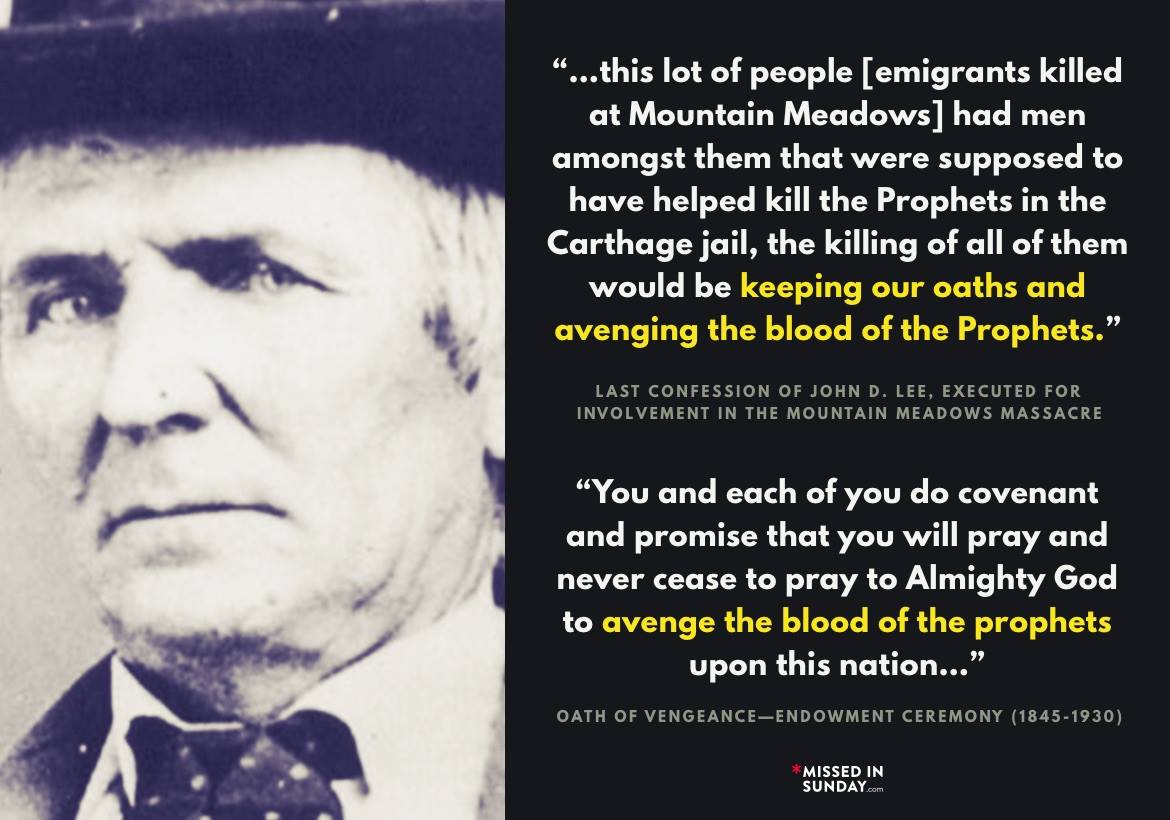
John D. Lee
September 11th marks the anniversary of the Mountain Meadows Massacre. A five day siege that culminated in the slaughter of some 120 California-bound immigrants in 1857, at the hands of Mormon militiamen (reinstated Nauvoo Legion) from Parowan, Utah.1
A month before the emigrants departed Arkansas on their journey west, Parley P. Pratt (LDS Apostle) was shot and stabbed by an estranged husband of his twelfth plural wife in the same state. Additionally there was war hysteria about a possible invasion into the Mormon territory by the U.S. government, placing the Mormon population on edge.
The wagon train of emigrants were bound for California on a route that passed through the Utah Territory. After arriving in Salt Lake, the Baker-Fancher party made their way south, eventually stopping to rest at Mountain Meadows. While camping at the meadow, nearby Mormon militia leaders, including Isaac C. Haight (LDS Stake President) and John D. Lee (adopted son, sealed to Brigham Young), joined forces to organize an attack on the wagon train.
Intending to give the appearance of Native American aggression, the militia’s plan was to arm some Southern Paiutes and persuade them to join with a larger party of their own militiamen—disguised as Native Americans—in an attack. During the militia’s first assault on the wagon train the emigrants fought back, and a five-day siege ensued. Eventually fear spread among the militia’s leaders that some emigrants had caught sight of white men and had likely discovered the identity of their attackers. As a result militia commander William H. Dame ordered his forces to kill the emigrants.
By this time the emigrants were running low on water and provisions, and allowed some approaching members of the militia—who carried a white flag—to enter their camp. John D. Lee, then local Indian agent, told them the Indians had gone, and if the Arkansans would lay down their arms, he and his men would escort them to safety. They were separated into three groups—the wounded and youngest children, who led the way in two wagons; the women and older children, who walked behind; and then the men, each escorted by an armed member of the militia.
Lee led his charges three-quarters of a mile from the campground to a southern branch of the California Trail. As they approached the rim of the Great Basin, a single shot rang out, followed by an order: “Do your duty!” The escorts turned and shot down the men, painted “Indians” jumped out of oak brush and cut down the women and children, and Lee directed the murder of the wounded.
Following the massacre, the perpetrators hastily buried the victims, leaving the bodies vulnerable to wild animals and the climate. Local families took in the surviving 17 children (all under 8 years of age), and many of the victims’ possessions were auctioned off.
Initially, the LDS Church denied any involvement by Mormons, and was relatively silent on the issue. Though an early investigation was conducted by Brigham Young, who interviewed John D. Lee on September 29th, 1857. Young sent a report to the Commissioner of Indian Affairs stating the massacre was the work of Native Americans. The Utah War delayed any investigation by the U.S. government until 1859, when Jacob Forney and Major James Henry Carleton conducted investigations. In Carleton’s investigation, at Mountain Meadows he found women’s hair tangled in sage brush and the bones of children still in their mothers’ arms. Carleton later said it was “a sight which can never be forgotten.” After gathering up the skulls and bones of those who had died, Carleton’s troops buried them and erected a cairn and cross with the inscription “Vengeance is mine, I will repay saith the Lord.”
During a tour of southern Utah, Brigham Young along with some 60 other Saints, visited the massacre site in May 1861. After viewing the inscription on the cross, Wilford Woodruff recorded President Young as saying “it should be vengeance is mine and I have taken a little.” The cross was then torn down and the rocks of the cairn were dismantled, leaving little of the original marker.
Captain James Lynch, who visited the site of the massacre in 1859, recorded his impressions:2
The scene of the fearful murder still bears evidence of the atrocious crime, charged by the Mormons and their friends to have been perpetrated by Indians but really by mormons disguised as Indians, who in their headlong zeal, bigotry and fanaticism deemed this a favorable opportunity of at once wreaking their vengeance on the hated people of Arkansas, and of making another of these iniquitious “Blood offerings” to God so often recommended by Brigham Young and their other leaders. For more than two square miles the ground is strewn with the skulls, bones and other remains of the victims. In places water has washed many of these remains together, forming little mounds, raising monuments as it were to the cruelty of man to his fellow man. Here and there may be found the remains of an innocent infant beside those of some devoted mother, ruthlessly slain by men worse than demons; their bones lie bleaching in the noon day sun a mute but eloquent appeal to a just but offended God for vengeance. I have witnessed many harrowing sights on the fields of battle, but never did my heart thrill with such horrible emotions, as when standing on that silent plain contemplating the remains of the innocent victims of Mormon Avarice, fanaticism & cruelty.
“Blood offerings” perhaps referencing the early mormon teaching of blood atonement that some crimes are so heinous that the atonement of Christ does not apply. Instead, to atone for these sins perpetrators should be killed in a way that would allow their blood to be shed upon the ground as a sacrificial offering. Brigham Young taught that a person who…
…has committed a sin that he knows will deprive him of that exaltation which he desires, and that he cannot attain to it without the shedding of his blood, and also knows that by having his blood shed he will atone for that sin, and be saved and exalted with the Gods, is there a man or woman in this house but what would say, ‘shed my blood that I may be saved and exalted with the Gods?’ All mankind love themselves, and let these principles be known by an individual, and he would be glad to have his blood shed. That would be loving themselves, even unto an eternal exaltation. Will you love your brothers or sisters likewise, when they have committed a sin that cannot be atoned for without the shedding of their blood? Will you love that man or woman well enough to shed their blood? That is what Jesus Christ meant. 3
:::
Excerpt from the last confession and statement of John D. Lee taken shortly before his execution for involvement in the Mountain Meadows massacre:4
I believed then as I do now, that it was the will of every true Mormon in Utah, at that time, that the enemies of the Church should be killed as fast as possible, and that as this lot of people had men amongst them that were supposed to have helped kill the Prophets in the Carthage jail, the killing of all of them would be keeping our oaths and avenging the blood of the Prophets.
The oath of vengeance was an addition made to the Nauvoo endowment under the direction of Brigham Young by 1845 in the Nauvoo Temple, soon after the 1844 death of Joseph Smith. Participants agreed to be bound by the following oath:
You and each of you do covenant and promise that you will pray and never cease to pray to Almighty God to avenge the blood of the prophets upon this nation, and that you will teach the same to your children and to your children’s children unto the third and fourth generation.5
References
References 1 Mountain Meadows massacre – https://en.m.wikipedia.org/wiki/Mountain_Meadows_massacre 2 Affidavit of Jame Lynch – https://www.mtn-meadows-assoc.com/james_lynch.htm 3 Journal of Discourses, vol.4, pp. 215–21. – http://contentdm.lib.byu.edu/cdm/ref/collection/JournalOfDiscourses3/id/9596 4 Last confession and statement of John D. Lee – http://www.mtn-meadows-assoc.com/jdlconfession.htm 5 Oath of vengeance, Wikipedia – https://en.wikipedia.org/wiki/Oath_of_vengeance -
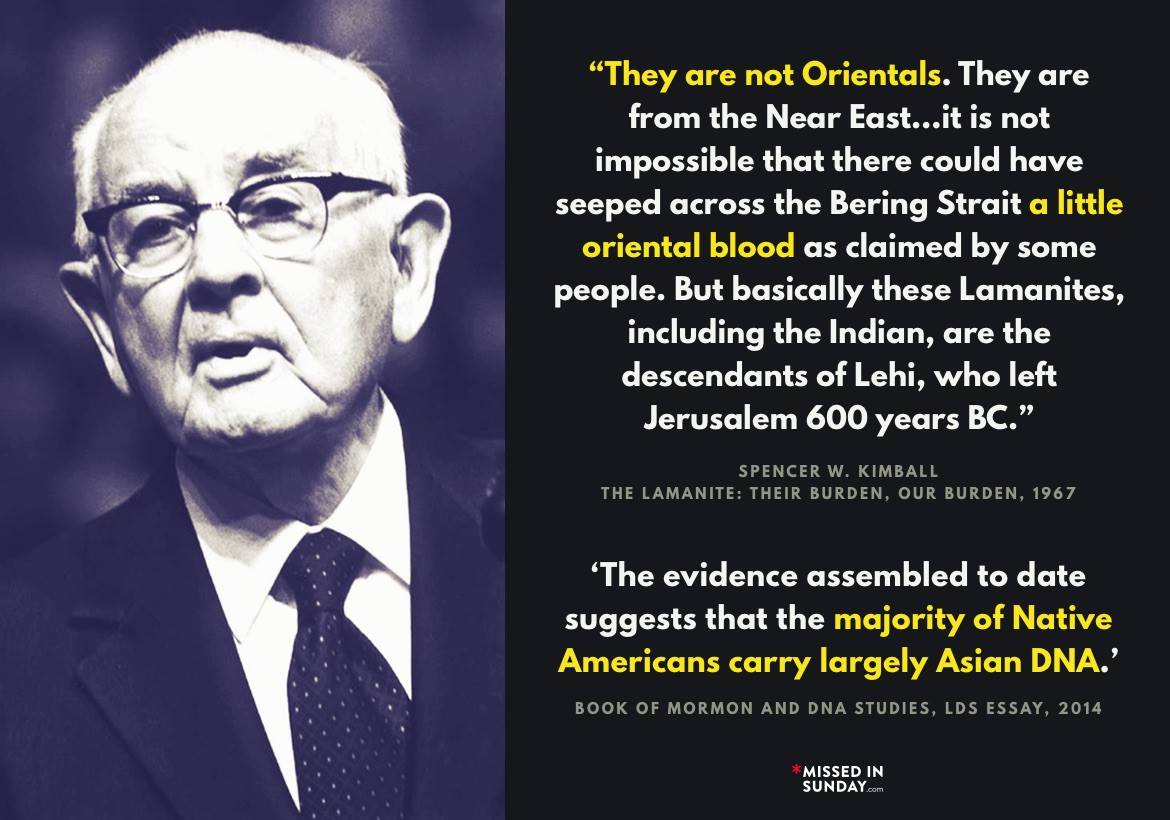
Book of Mormon and DNA
Excerpt from the ‘Book of Mormon and DNA Studies’, LDS Gospel Topic Essay: 1
The evidence assembled to date suggests that the majority of Native Americans carry largely Asian DNA. Scientists theorize that in an era that predated Book of Mormon accounts, a relatively small group of people migrated from northeast Asia to the Americas by way of a land bridge that connected Siberia to Alaska. These people, scientists say, spread rapidly to fill North and South America and were likely the primary ancestors of modern American Indians.
Spencer W. Kimball
The Lamanite: Their Burden, Our Burden
Feb. 9, 1967 2(0:00)
My beloved brothers and sisters. My fellow Indian students. It’s a joy to be with you and I appreciate this privilege of being with you, especially this week, during the Indian week.The Indian is the Lamanite. They are South Americans, Central Americans, Mexican, Polynesian and other Lamanites running into millions who are not specifically called Indians though they are related Lamanites.
The Lamanites are a mixture of many. Undoubtably there is in their veins the blood of Nephi, Joseph and Jacob as well as that of Laman, Lemuel and Sam. Also of the Mulekites of Judah. They are not Orientals. They are from the Near East. The twelve apostles who were associated with the prophet Joseph proclaimed this to the world. Quoting “He, the Lord, has revealed the origin and the records of the aboriginal tribes of America and their future destiny, and we know it.”
We also bear testimony that the Indians, so-called, of North and South America are a remnant of the tribes of Israel. Through the centuries, movements, discovery, explorations, settlement and colonization of the people of this land—it is not impossible that there could have seeped across the Bering Strait a little oriental blood as claimed by some people. And possibly a little Norse blood may have crossed the North Atlantic. But basically these Lamanites, including the Indian, are the descendants of Lehi, who left Jerusalem 600 years BC. In the general sense, we are the Gentiles having come from Gentile nations. The name ‘Indians’, given to the early possessors of the Americas by Columbus, as they intermarried with the invading European conquerers and nations were formed, they became Mexicans, Peruvians, Bolivians, Guatemalans and others. But the correct name for all the descendants of Lehi and Ishmael is Lamanite.
This is an honorable name. It was the Lord who so designated it. Every descendant of Lehi should proudly say “I am a Lamanite, and I am proud of my heritage.” The Book of Mormon was written to the laminates who are a remnant of Israel, for the express purpose of convincing the Jew and the Gentile that Jesus is the Christ, the eternal God. And that the Lamanites might know their ancestors and the spectacular promises of the Lord to them.
(4:25)
Wilford Woodruff, president of the Lords church, identified many of the larger tribes as Lamanites. President Joseph Smith and John Taylor called them lamanites as have all the presidents and leaders of the church since. And so we look upon the name as proper and dignified and fully acceptable. The Lord consistently called his people the Lamanites.(4:58)
He [Moroni] probably saw with rather clear vision the deterioration, becoming savages without a written language, ignorant, superstitious and without God in their lives.(5:29)
Undoubtably, he [Moroni] saw the inspired Columbus bridge the mighty deep and bring two worlds together. The explorers, the discoverers, the conquerers, the colonists, peopled the land. He would have seen the growing gentile nation throw off the thralldom of it’s mother country in the great revolutionary war. There, developing a constitution, and freedom, and all of this was in preparation for the restoration of the gospel with the Book of Mormon.(15:18)
Whereas the Lamanites had been as numerous as the sands of the sea, through disease and warfare these numbers had dwindled by the time Columbus came. Likely there were fewer in the whole land left, than were killed in the one battle of Cumorah.References
References 1 Book of Mormon and DNA Studies, LDS Gospel Topic Essay – https://www.lds.org/topics/book-of-mormon-and-dna-studies?lang=eng 2 The Lamanite: Their Burden, Our Burden, BYU Speeches (audio) – https://teknik.byu.edu/talks/spencer-w-kimball_lamanite-burden-burden/ -

The Late War
Image: Title page of The Late War Between the United States and Great Britain, by Gilbert J. Hunt
[footnote]The Late War Between the United States and Great Britain, Gilbert J. Hunt[/footnote]
A single example out of hundreds between The Late War (published 1816) and The Book of Mormon (Published 1830).
The Late War Between the United States and Great Britain, by Gilbert J. Hunt – 34:10
But it came to pass, in the same year, that the people of Columbia were revenged of the evil:
The Book of Mormon – Alma 50:30
And it came to pass that in the same year that the people of Nephi had peace restored unto them…
New York, 1816: When Joseph Smith was 12 years old, Gilbert Hunt published a scriptural style account of the War of 1812, titled “The Late War between the United States and Great Britain.” The book was marketed for the use of schools throughout the United States” under the title The Historical Reader. Written in King James style English and laced with chiastic literary structure, The Late War bears remarkable similarities to The Book of Mormon, published over a decade later.
Possible explanations for the similarities include:
1. The Late War was a direct source for some of the language and content of the Book of Mormon.
2. The Book of Mormon was consciously styled in the language of The Late war but was not dependent on it for literary content.
3. The parallels between the BoM and the LW are incidental and both books merely reflect a style of writing in KJV prose that was conventional during the period.Whatever the connection between the two volumes, the similarities clearly reflect the milieu in which they were created. The Late War and The Book of Mormon look exactly like you would expect two books with similar themes coming out of early 19th century frontier America.
For a side-by-side comparison between the two volumes and added contextual information – A Comparison of The Book of Mormon and the Late War
Also read the original text – The Late War Between the United States and Great Britain
Crash Course:
The Book of Mormon and the Late War: Direct Literary Dependence?
A Comparison of The Book of Mormon and the Late War – Word Tree Foundation
A Historical Analysis of The Late War – Rick Grunder
2015 Presentation: The Late War and the Book of Mormon
Indian Origins and the Book of Mormon (video) – Dan Vogel -
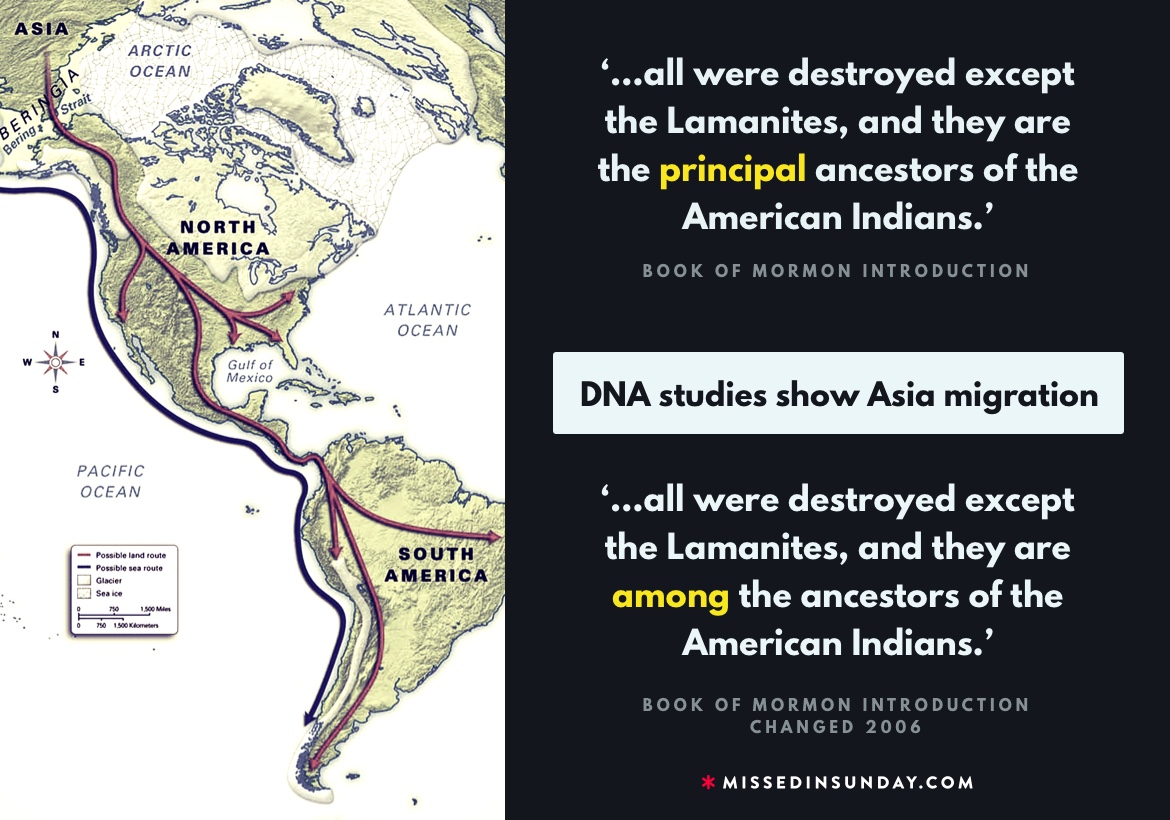
Double Helix
Image: Asianic migration routes of the Native Americans.
The introduction to the Book of Mormon:[footnote]Introduction to the Book of Mormon – LDS.org [/footnote]
The book was written by many ancient prophets by the spirit of prophecy and revelation. Their words, written on gold plates, were quoted and abridged by a prophet-historian named Mormon. The record gives an account of two great civilizations. One came from Jerusalem in 600 B.C. and afterward separated into two nations, known as the Nephites and the Lamanites. The other came much earlier when the Lord confounded the tongues at the Tower of Babel. This group is known as the Jaredites. After thousands of years, all were destroyed except the Lamanites, and they are the principal ancestors of the American Indians.
In 2006, after DNA studies began confirming Asianic migration rather than Middle Easter migration the text was changed to read:[footnote]Single word change in Book of Mormon speaks volumes – Salt Lake Tribune [/footnote]
The book was written by many ancient prophets by the spirit of prophecy and revelation. Their words, written on gold plates, were quoted and abridged by a prophet-historian named Mormon. The record gives an account of two great civilizations. One came from Jerusalem in 600 B.C. and afterward separated into two nations, known as the Nephites and the Lamanites. The other came much earlier when the Lord confounded the tongues at the Tower of Babel. This group is known as the Jaredites. After thousands of years, all were destroyed except the Lamanites, and they are among the ancestors of the American Indians.
Crash Course:
Single word change in Book of Mormon speaks volumes – Salt Lake Tribune
A genomic view of the peopling of the Americas – Harvard University
Book of Mormon and DNA Studies – Gospel Topic Essay
Simon Southerton, DNA, Lamanites and the Book of Mormon (podcast) – Mormon Stories -
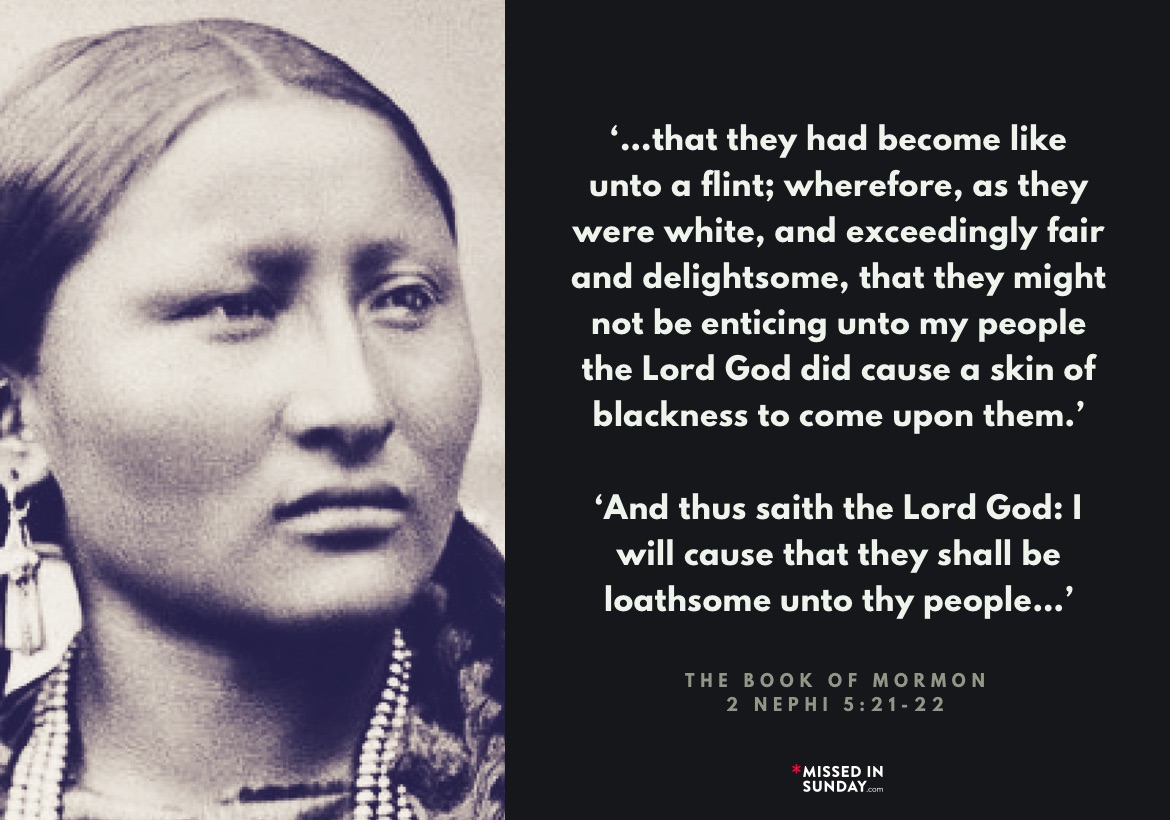
Loathsome
The Book of Mormon (2 Nephi 5:21-25), in describing the ‘curse of dark skin’ that afflicted the Lamanites (American Indian), reads:[footnote]2 Nephi 5 – The Book of Mormon [/footnote]
21 And he had caused the cursing to come upon them, yea, even a sore cursing, because of their iniquity. For behold, they had hardened their hearts against him, that they had become like unto a flint; wherefore, as they were white, and exceedingly fair and delightsome, that they might not be enticing unto my people the Lord God did cause a skin of blackness to come upon them.
22 And thus saith the Lord God: I will cause that they shall be loathsome unto thy people, save they shall repent of their iniquities.
23 And cursed shall be the seed of him that mixeth with their seed; for they shall be cursed even with the same cursing. And the Lord spake it, and it was done.
24 And because of their cursing which was upon them they did become an idle people, full of mischief and subtlety, and did seek in the wilderness for beasts of prey.
25 And the Lord God said unto me: They shall be a scourge unto thy seed, to stir them up in remembrance of me; and inasmuch as they will not remember me, and hearken unto my words, they shall scourge them even unto destruction.
2 Nephi 5 – The Book of MormonWhite and Delightsome or Pure and Delightsome? – Mormon Research MinistryBlacks and the Priesthood – Mormon ThinkBlack people in Mormon doctrine – WikipediaStatements about race in the Book of Mormon – Religious ToleranceRace and the Priesthood Essay – LDS.orgMormon racism in perspective – Elder Mark E. Peterson -
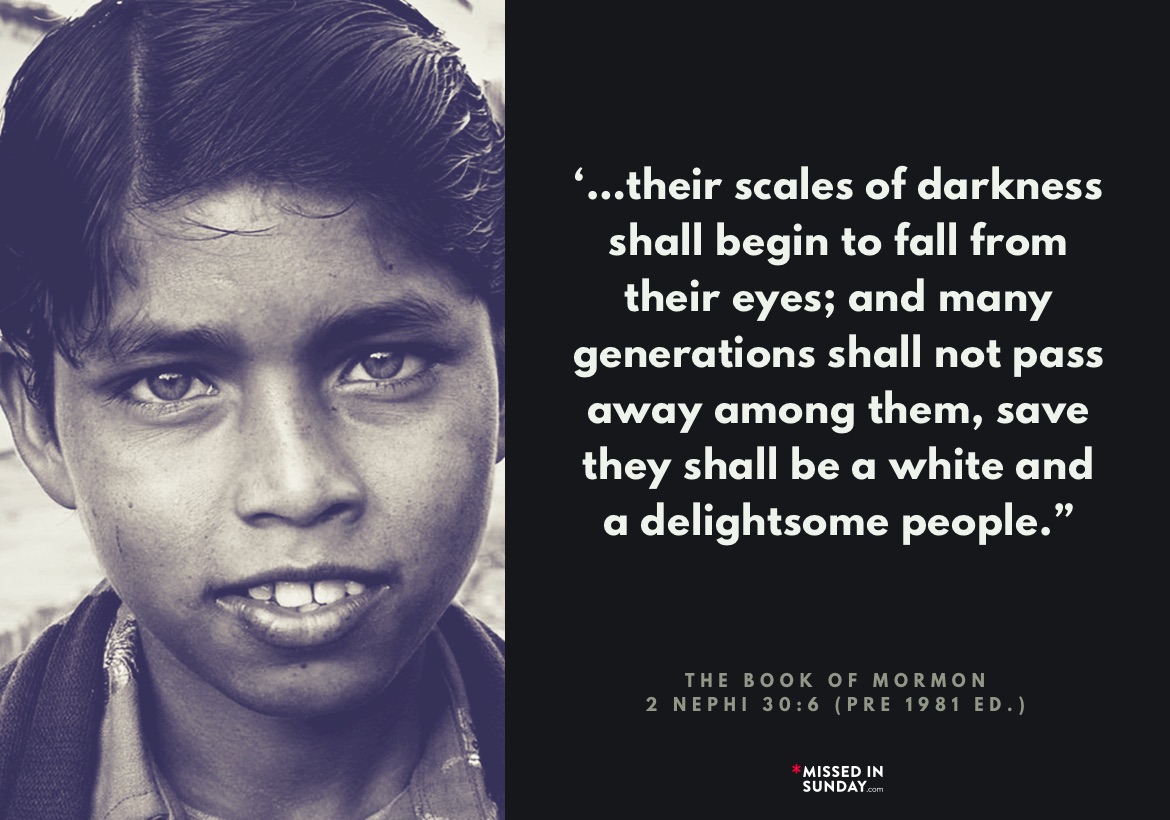
Scales of Darkness
Until 1981 2 Nephi 30:6 in the Book of Mormon taught that dark-skinned Lamanites (Indians) would eventually experience a change in the color of their skin should they embrace the Book of Mormon. This passage read:
“And then shall they rejoice; for they shall know that it is a blessing unto them from the hand of God; and their scales of darkness shall begin to fall from their eyes; and many generations shall not pass away among them, save they shall be a white and a delightsome people.”
In 1981 the Church changed the text of The Book of Mormon to read:
“And then shall they rejoice; for they shall know that it is a blessing unto them from the hand of God; and their scales of darkness shall begin to fall from their eyes; and many generations shall not pass away among them, save they shall be a pure and a delightsome people.”
White and Delightsome or Pure and Delightsome? – Mormon Research MinistryBlacks and the Priesthood – Mormon ThinkBlack people in Mormon doctrine – WikipediaStatements about race in the Book of Mormon – Religious ToleranceRace and the Priesthood Essay – LDS.orgMormon racism in perspective – Elder Mark E. Peterson -
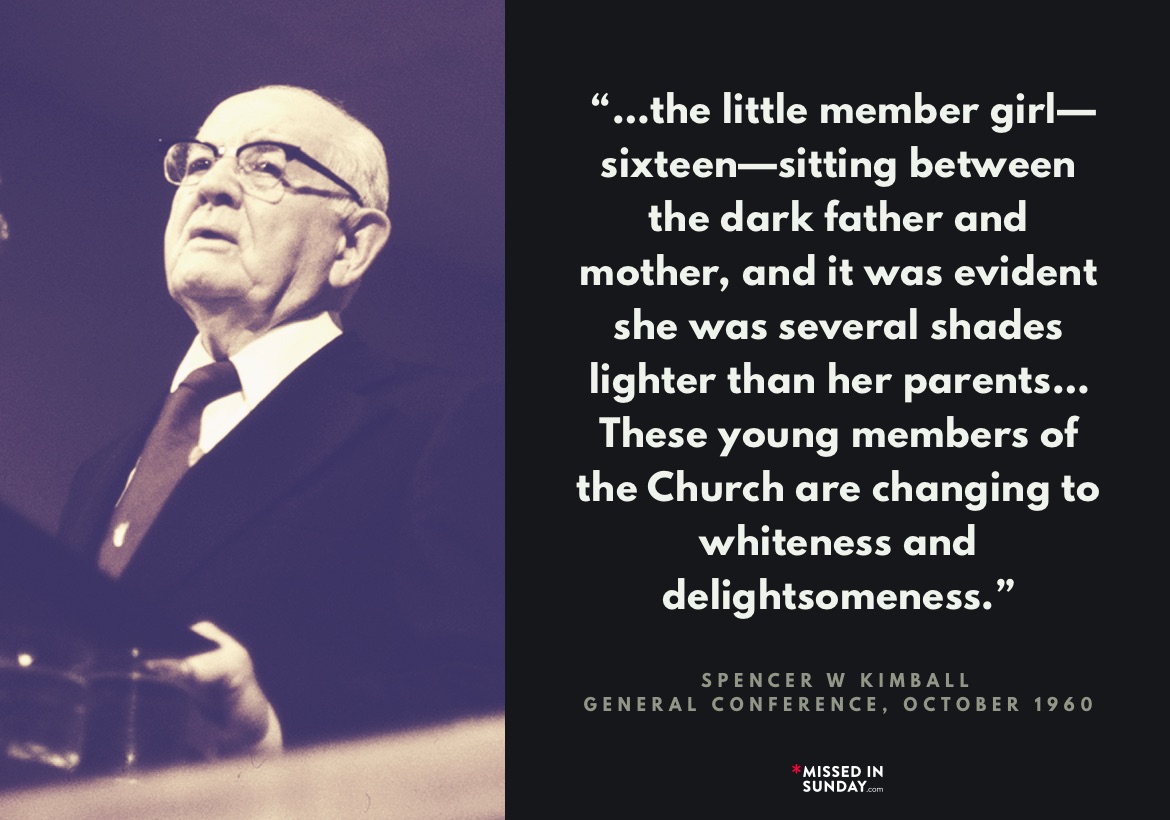
Shades Lighter
Image: Spencer W. Kimball
From the October 1960 LDS General Conference, Spencer W. Kimball:[footnote]The Day of the Lamanites -1960 General Conference, Spencer W. Kimball [/footnote]
“At one meeting a father and mother and their sixteen-year-old daughter were present, the little member girl—sixteen—sitting between the dark father and mother, and it was evident she was several shades lighter than her parents—on the same reservation, in the same hogan, subject to the same sun and wind and weather. There was the doctor in a Utah city who for two years had had an Indian boy in his home who stated that he was some shades lighter than the younger brother just coming into the program from the reservation. These young members of the Church are changing to whiteness and to delightsomeness. One white elder jokingly said that he and his companion were donating blood regularly to the hospital in the hope that the process might be accelerated.”
The Day of the Lamanites -1960 General Conference, Spencer W. KimballBlacks and the Priesthood – Mormon ThinkBlack people in Mormon doctrine – WikipediaStatements about race in the Book of Mormon – Religious ToleranceRace and the Priesthood Essay – LDS.orgMormon racism in perspective – Elder Mark E. Peterson -
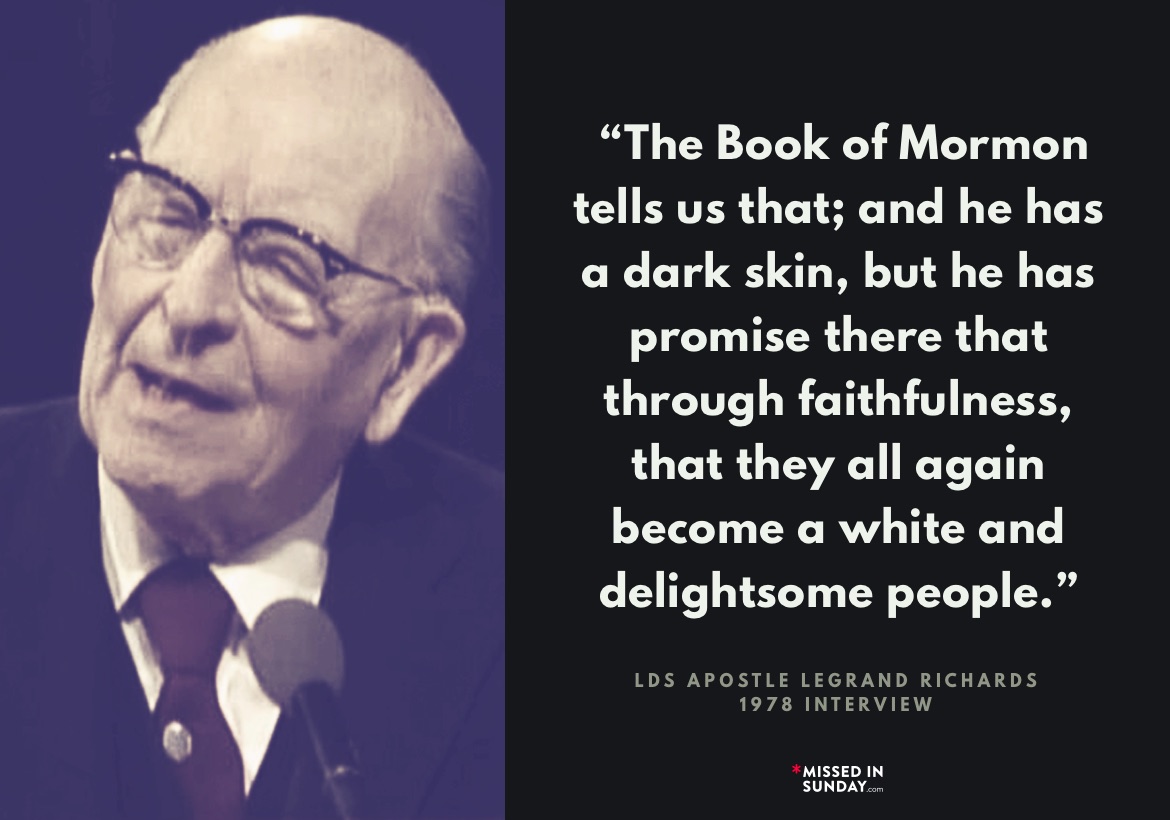
White and Delightsome
Image: Apostle LeGrand Richards
In a 1978 interview Apostle LeGrand Richards spoke on the topic of ‘giving the priesthood to the Negro’:[footnote]Interview with Apostle LeGrand Richards -16th August 1978, Church office Building [/footnote]
WALTERS (Interviewer): Is there still a tendency to feel that people are born with black skin because of some previous situation, or do we consider that black skin is no sign anymore of anything inferior in any sense of the word?
RICHARDS: Well, we don’t want to get that as a doctrine. Think of it as you will. You know, Paul said “Now we see in part and we know in part; we see through a glass darkly. When that which is perfect is come, then that which is in part shall be done away, then we will see as we are seen, and know as we are known.” Now the Church’s attitude today is to prefer to leave it until we know. The Lord has never indicated that black skin came because of being less faithful. Now, the Indian; we know why he was changed, don’t we? The Book of Mormon tells us that; and he has a dark skin, but he has a promise there that through faithfulness, that they all again become a white and delightsome people. So we haven’t anything like that on the colored thing.
Interview with Apostle LeGrand Richards – 16th August 1978, Church office BuildingBlacks and the Priesthood – Mormon ThinkBlack people in Mormon doctrine – WikipediaStatements about race in the Book of Mormon – Religious ToleranceRace and the Priesthood Essay – LDS.orgMormon racism in perspective – Elder Mark E. Peterson -
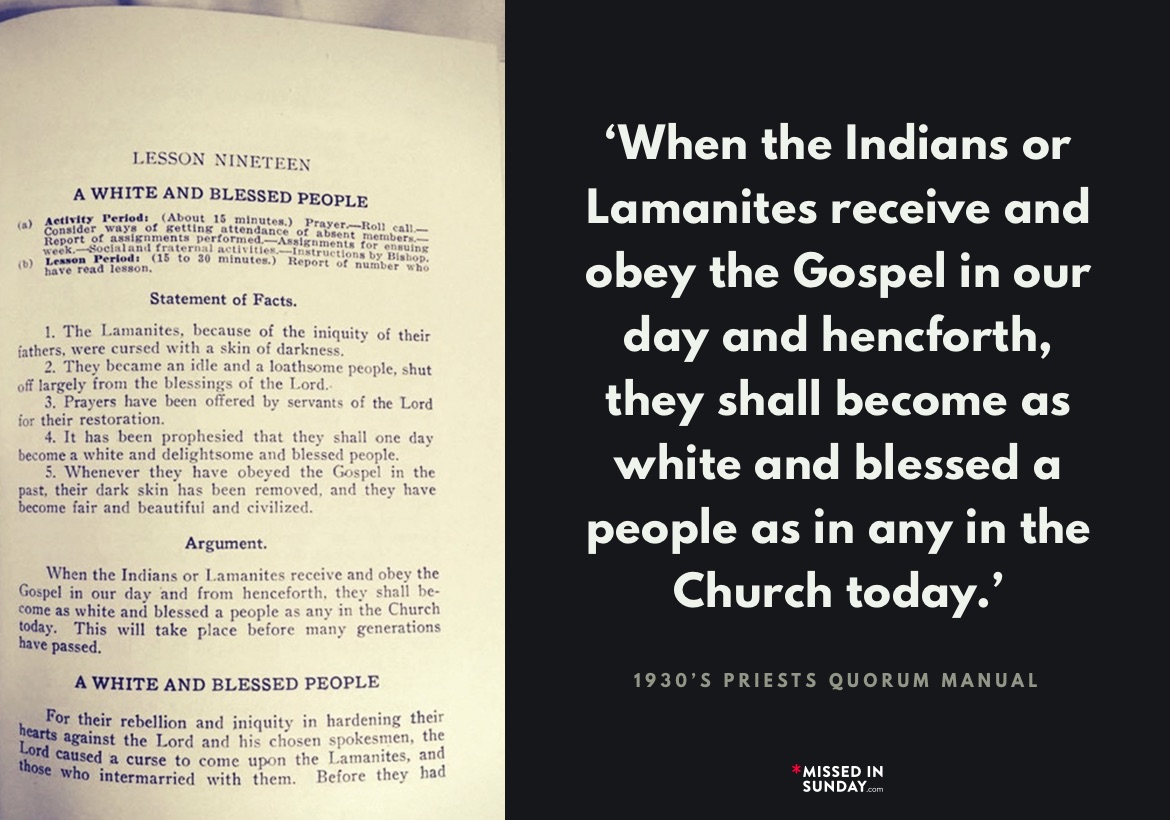
Becoming White
Lesson 19, A white and Blessed People:[footnote]Manual for the Priests’ Quorum, Nephi Jensen – Deseret News Press, 1927 [/footnote]
LESSON NINETEEN
A WHITE AND BLESSED PEOPLE
(a) Activity Period: (About 15 minutes.) Prayer.—Roll Call—Consider ways of getting attendance of absent members.—Report of assignments performed.—Assignments for ensuing week.—Social and fraternal activities.—Instructions by Bishop.
(b) Lesson Period: (15 to 30 minutes.) Report of number who have read lesson.
Statement of Facts.
- The Lamanites, because of the iniquity of their fathers, were cursed with a skin of darkness.
- They became an idle and a loathsome people, shut off largely from the blessings of the Lord.
- Prayers have been offered by servants of the Lord for their restoration.
- It has been prophesied that they shall one day become a white and delightsome and blessed people.
- Whenever they have obeyed the Gospel in the past, their dark skin has been removed, and they have become fair and beautiful and civilized.
Argument.
When the Indians or Lamanites receive and obey the Gospel in our day and from henceforth, they shall become as white and blessed a people as any in the Church today. This will take place before many generations have passed.
A WHITE AND BLESSED PEOPLE
For their rebellion and iniquity in hardening their hearts against the Lord and his chosen spokesmen, the Lord caused a curse to come upon the Lamanites, and those who intermarried with them. Before thy had…
Blacks and the Priesthood – Mormon ThinkBlack people in Mormon doctrine – WikipediaStatements about race in the Book of Mormon – Religious ToleranceRace and the Priesthood Essay – LDS.orgMormon racism in perspective – Elder Mark E. Peterson

